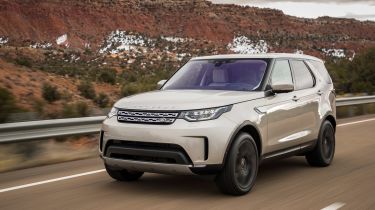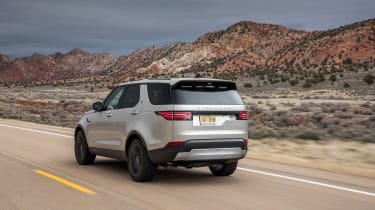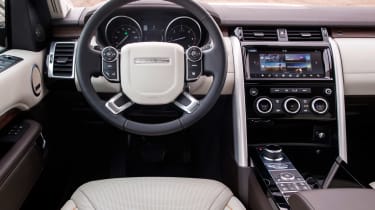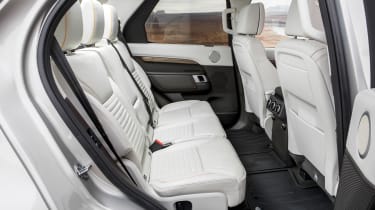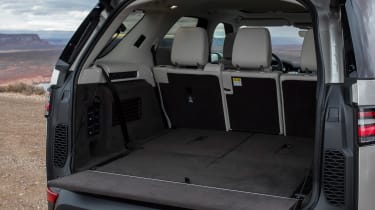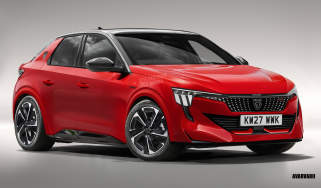New Land Rover Discovery SD4 2017 review
The new Land Rover Discovery mk5 takes the 'utility' part of the ever-popular SUV formula to new heights

The fifth-generation Discovery is more refined than ever, while the addition of four-cylinder diesel power has opened up the brand’s big SUV to a new group of buyers looking for lower running costs combined with the versatility of an upmarket seven-seat 4x4. Here the Disco excels, while it’s imperious off-road, too. Factor in some smart new technology and it’s a very capable package indeed.
Volvo proved with its latest XC90 that premium seven-seat SUVs can still sell in their droves when fitted with a four-cylinder diesel engine – and the new Land Rover Discovery is following suit by launching with a 237bhp version of the firm’s 2.0-litre Ingenium four-cylinder turbodiesel.
And there’s one key reason why the British brand has been able to offer a downsized motor – and that’s weight. Or rather the lack of it.
• Best 4x4s and SUVs to buy now
With an aluminium monocoque underpinning this fifth-generation Discovery as opposed to its predecessor’s twin chassis ladder frame design, the Land Rover is now a lot lighter. Fitted with the four-cylinder diesel tested here, the kerbweight has not so much as been shaved – but slashed by 480kg.
This has some big benefits. The first is performance. With 500Nm of torque the Sd4 engine will accelerate the new Discovery from 0-62mph in 8.3 seconds. It’s not what you’d call fast, but it’s only two tenths slower than the more potent V6 diesel (which has 100Nm more torque) over the benchmark sprint.
More reviews
Car group tests
In-depth reviews
Long-term tests
Road tests
- Land Rover Discovery (Mk1, 1989-1998) icon review
- New Land Rover Discovery Metropolitan Edition 2022 review
- New Land Rover Discovery 2021 review
- New Land Rover Discovery Si6 2018 review
Used car tests
Mated to an eight-speed automatic gearbox that manages changes seamlessly, the engine delivers its power in a smooth and progressive fashion. There’s no great gain to be had by working it hard, as revving it makes its four-cylinder configuration more apparent compared to the smoother V6. Instead, it’s much more appropriate to use the torque and let the gearbox keep the engine in its sweet spot. It’s more refined here, too.
The second benefit of the weight saving is efficiency. Downsizing means claimed fuel economy is up to 43.5mpg while CO2 stands at 171g/km. As a result, the Land Rover should be much cheaper to run than before – especially if you’re a company car buyer, thanks to its low emissions and the car’s relatively affordable £43,495 starting price in entry-level S spec.
Even this bottom rung of the range gets air suspension as standard, which contributes towards the Disco’s impressive refinement. Land Rover says it’s pretty much on a par with a Range Rover in terms of noise inside, which is high praise indeed.
It feels it, too. The aluminium chassis uses a similar architecture and suspension components to the Range Rover, and the damping gives the Discovery a similarly languid, unhurried feeling on the move.
The roads on our test route in Utah were mostly smooth, so we’ll have to wait to see how the car deals with broken British tarmac, but over the poorer surfaces we encountered, the Discovery smothered bumps with welcome composure. Over the worst impacts you can still feel a gentle jolt, but given the big wheels, it still rides well for such a large car.
But that’s because it is large; and there’s no cheating physics. The body is now 141mm longer than before while the wheelbase has also grown by 38mm compared with its predecessor.
It’s relatively agile, though. The steering is light but responds well, with adequate levels of grip on offer. There’s no active roll control, so the big, tall Disco does lean a little in corners, but the focus here is on comfort rather than nimbleness, so even with its newfound, keener sense of agility through direction changes, it still feels cumbersome at times.
There’s plenty of space inside. Land Rover claims two fully-grown adults will be comfy in the third row, and jumping into the very back seats it’s obvious there’s plenty of room.
Unlike some seven seaters, your knees don’t touch the seats in front. Headroom is also good, while stadium seating for the rear two rows means the view out isn’t too bad, also giving the Discovery its traditional step in the roof along with a few other distinctive styling cues such as the clamshell bonnet and slanted C pillar.
The middle seats slide back and forth and can be folded using switches in the boot, on the rear door pillar, through the 10-inch InControl Touch Pro infotainment system or using JLR’s InControl Remote smartphone app – taking up to 15 seconds to lower depending which seats are being folded.
However, once slid forward (manual only) and the back rests angled, the big C-pillar means you still have to climb up and into the back row through a relatively tight aperture.
With the third row in place there’s a 258-litre boot, which rises to an incredibly useful 1,137 litres in five-seat form. Drop the back seats and the resulting 2,406 litres of load space makes the Discovery a cavernous way to cart lots of stuff around. A power tailgate is also standard.
With plenty of neat storage areas it has the drop on rivals here too, while the tech on offer furthers the flexibility served up by the Discovery. Advanced Tow Assist, which will help steer the rig for you while reversing, and Land Rover’s Terrain Response 2 system, which automatically adapts the car’s drivetrain and suspension settings to the surface, highlight some of the other tech on offer – and as we know from our early drive off-road in Scotland, the Discovery is highly talented when it comes to all terrain ability.
All trim levels get autonomous braking as standard, while upgrading to SE adds leather, sat-nav, LED headlights and all-round parking sensors. Go for HSE trim and you get the larger 10-inch multimedia touchscreen with a Meridian stereo, a panoramic roof, keyless entry and a rear-view camera on top.
Although the price rises to £56,995 for this four-cylinder HSE model, the level of versatility, style, unparalleled off-road ability and – most importantly – on-road comfort, makes the Discovery one of, if not the most complete car in its class.

